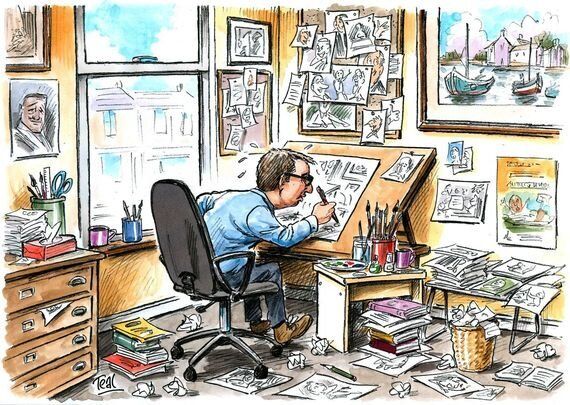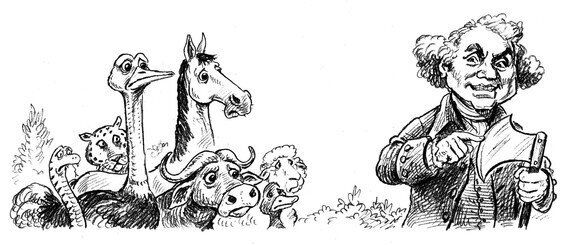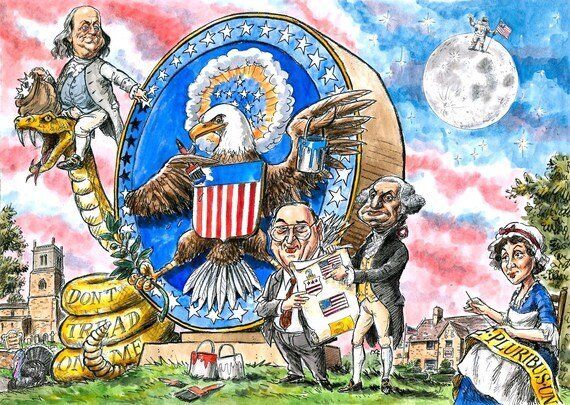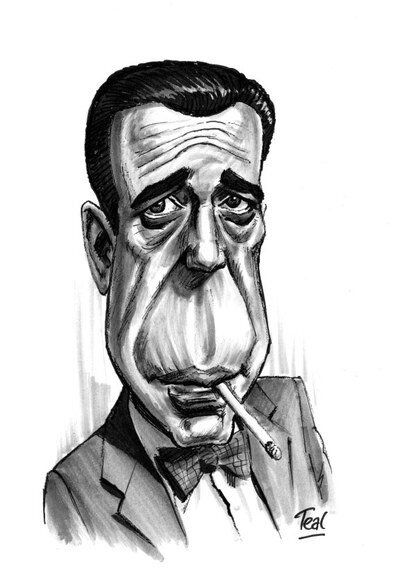
"Every face can be reduced to a basic shape," Adrian Teal declares as he adjusts his square-rimmed glasses and begins drawing on the blank piece of paper before him. "Take, for example, this cube."
I peer over his shoulder, anticipating something akin to a magic trick. As someone whose own artistic skills never developed past the first grade (two-dimensional square houses with rectangular chimneys and squiggly lines to signify smoke), I am utterly fascinated with people who can draw.
"I'm going to turn this cube into Humphrey Bogart's face," he says. And sure enough--after a few strokes from his graphite pencil--the actor's iconic hangdog expression begins to emerge.
Teal has been studying faces for as long as he can remember. As an "ankle-biter," he used to get under everyone's feet at the Spitting Image Workshop. He received tuition from two of the show's creators, Roger Law and Peter Fluck, as well as a young David Stoten, who Teal lauds as "the most talented caricaturist in the world."
"For a kid obsessed with caricature, the workshop was like Disneyland," he says, wistfully. "It was such a vibrant environment, with extraordinarily talented people doing fascinating things in every corner. There were stacks of puppets, wig-makers, costumes, swivelling eyeballs being fitted into the heads of world leaders, and the all-pervasive, chemical stench of raw foam rubber filled the air."
Over time, Teal became a brilliant caricaturist in his own right. His political cartoons have appeared in the Sunday Telegraph, The Scotsman, the Sun, and the Daily Mail, to name a just a few. But it was his love of history and talent for writing that prompted him to publish The Gin Lane Gazette--an illustrated compendium of bawdy stories about Georgian England--in 2012.
How exactly does a caricaturist recreate the past?
"I like to think and imagine my way into history. I don't really see how else one can do it," he says as I flip through the vividly illustrated pages of his book. "Aside from artefacts and locations, history really only exists as words and pictures on paper or vellum."
I pause on a story about the 18th-century anatomist, John Hunter, whose habit for dissecting anything and everything he could get his hands on is well known to medical historians like myself. Teal depicts Hunter gleefully holding a sharp axe while his exotic "pets" linger in the background, their brows furrowed with concern.

"My approach is perhaps undisciplined, and would probably horrify academics, but by immersing myself in the visual and textual world of the 1700s, and then presenting my impressions of the period in the way I have, I hope I've captured a tiny bit of the essence of how life was lived in that gloriously exuberant and eccentric century."
Perhaps his approach is a bit unorthodox, but Teal's attention to historic detail in The Gin Lane Gazette is second to none. Men's collars--noticeably absent in the 1760s and 1770s--suddenly appear with great fanfare in the 1780s. Women's wigs get higher and higher with each passing decade until they take up entire pages. Even the prices of the fictional newspaper increase, accurately reflecting the rate of inflation during the Georgian period.
"I was clear from the beginning that I wanted everything to be accurate, and I was meticulous in my research. Mind you, the 18th century is so wonderfully bawdy and bizarre that you don't really need to make stuff up." Indeed, he doesn't.
Teal's love of 18th-century history goes beyond the shores of Great Britain. This September, he will travel to Grand Rapids, Michigan, to enter ArtPrize, an international art competition that draws half a million visitors from around the world each year, and awards contestants $560,000 in prizes.
"My painting will be a gigantic caricature--measuring 6 x 8.5 feet--incorporating the fascinating history of some of America's most important and recognizable national emblems, and the people who helped forge them." Some of the 18th-century's greatest heroes, such as George Washington and Ben Franklin, will feature prominently in Teal's forthcoming piece, dubbed The Great Seal.

But where did he find his inspiration for such a caricature?
"My village of Ecton in Northamptonshire shares a direct link with American history. It is the resting place of Benjamin Franklin's uncle. He visited the grave in the 1750s, and even considered buying back his family's homestead in the village."
And it doesn't end there.
"A few miles down the road is Sulgrave Manor, the ancestral home of George Washington, and the family coat of arms emblazoned above the manor's porch is said to have influenced the design of the Stars and Stripes."
Teal, who has been having a "jolly" time learning about American history, is understandably concerned about the challenges that lie ahead as he prepares to travel to Michigan this autumn. It's not just the scale of the caricature that is daunting. It's the fact that he doesn't want to be seen "as a jumped-up Brit trying to spoon-feed America its own history."
As an American, myself, I believe his worries are unfounded. Teal's talent for bringing history to life through art, and his enthusiasm for discovering links between America and Great Britain's past, is what will make The Great Seal a truly great piece of artwork.
Teal falls silent as his pencil begins to move effortlessly across the paper once more. "You know," he says after awhile, "anyone can draw." It would seem that Teal has adopted America's democratic sentimentalities about the limitless nature of human potential. Nevertheless, as I watch him put the final touches on the Bogart sketch, I remain respectfully sceptical of his claim. After all, not many people can turn a cube into this.

Adrian Teal will be making appearances at the Holland Museum and the 8th Street Grille in Holland, Michigan this September in the lead-up to ArtPrize. If you'd like to help him on his journey, click here.